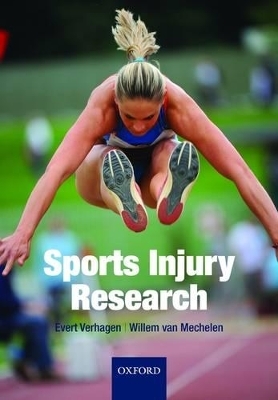
Sports Injury Research
Oxford University Press (Verlag)
978-0-19-956162-9 (ISBN)
With the increasing focus on tackling obesity and other lifestyle-related illnesses and conditions, participation in sports and physical activity is growing. The consequences are that injuries and unwanted side-effects of healthy activity are becoming major health problems. Prevention is crucial to health gain, both in the short-term (preventing immediate injury), and in the longer term (reducing the risk of recurrence and prolonged periods of impairment). Prevention follows 4 main steps: 1) the sports injury problem must be described in incidence and severity, 2) the etiological risk factors and mechanisms underlying the occurrence of injury are identified, 3) preventive methods that are likely to work can be developed and introduced, and 4) the effectiveness and cost-effectiveness of such measures are evaluated.
This book follows these four steps to provide a comprehensive guide to the epidemiology and methodology involved in sports injury research. It includes detailed background on epidemiological methods employed in research on sports injuries, discusses key methodological issues, and teaches the reader to recognize the influence of the employed methodology on interpretations of study results. Theoretical knowledge is integrated with practical examples throughout. The book will be of value to all researchers and professionals, both clinicians and epidemiologists, in the field of sports medicine.
Evert Verhagen is a senior researcher of the department of Public and Occupational Health at the VU University Medical Centre in Amsterdam. He completed his masters in Human Movement Sciences in 1999. As a former Track & Field athlete who had to cease participating at the elite level on the age of 17 due to an injury, he has a natural interest in sports and physical activity injury prevention. Evert received his PhD in 2004 after emphasising the preventive effect balance training has against ankle sprains. He gained his mark for his work on the prevention of ankle sprains, but also has a strong focus on safety and injury prevention in youth sports and physical activity, as well as the uptake of the interventions within a broad sporting population. He is a board certified occupational epidemiologist and human movement scientist. He is a member of a great number of (inter-)national committees and advisory boards, as well as a member of the editorial board of 3 international peer-reviewed journals. Prof Willem van Mechelen worked for 9 years at an Amsterdam high school as a PE teacher, combining this with studying medicine at the University of Amsterdam. After his certification as an MD in 1982 he started working at various out-patient clinics as a sports and occupational physician. He also started in that year his scientific career with a part-time appointment at the Faculty of Human Movement Sciences of the Vrije Universiteit in Amsterdam. He earned his PhD in Human Movement Sciences in 1992. Currently, he is employed by the VU University Medical Centre in Amsterdam as a full professor of Occupational and Sports Medicine. In this capacity he is the head of the Department of Public and Occupational Health, co-director of the EMGO Institute, vice-dean of the Netherlands School of Public and Occupational Health and director of Research Centre Body@Work TNO VUmc. He leads a group of about 40 persons who conduct primary care research in the area of work, physical activity, sport and health.
PART 1: KEY ISSUES IN EPIDEMIOLOGY AND METHODOLOGY ; 1. Defining a research question ; 2. Study designs ; 3. Basic statistical methods ; PART 2: DEFINING THE INJURY PROBLEM ; 4. Injury definitions ; 5. Research designs for descriptive studies ; 6. Statistics used in descriptive studies ; 7. Reviews - using the literature to your advantage ; PART 3: ESTABLISHING INJURY AETIOLOGY ; 8. The multi-causality of injury - current concepts ; 9. Investigating injury risk factors and mechanisms ; 10. Statistics in aetiological studies ; PART 4: DEVELOPMENT OF PREVENTIVE MEASURES ; 11. The pragmatic approach ; 12. The behavioural approach ; PART 5: EVALUATING THE EFFICACY AND EFFECTIVENESS OF PREVENTIVE MEASURES ; 13. Research designs for evaluation studies ; 14. Statistics used in effect studies ; 15. Cost-effectiveness studies ; 16. Implementing studies into real life
| Erscheint lt. Verlag | 3.12.2009 |
|---|---|
| Zusatzinfo | Various black and white line drawings and halftones |
| Verlagsort | Oxford |
| Sprache | englisch |
| Maße | 172 x 246 mm |
| Gewicht | 522 g |
| Themenwelt | Medizin / Pharmazie ► Medizinische Fachgebiete ► Sportmedizin |
| Studium ► Querschnittsbereiche ► Epidemiologie / Med. Biometrie | |
| ISBN-10 | 0-19-956162-1 / 0199561621 |
| ISBN-13 | 978-0-19-956162-9 / 9780199561629 |
| Zustand | Neuware |
| Haben Sie eine Frage zum Produkt? |
aus dem Bereich


